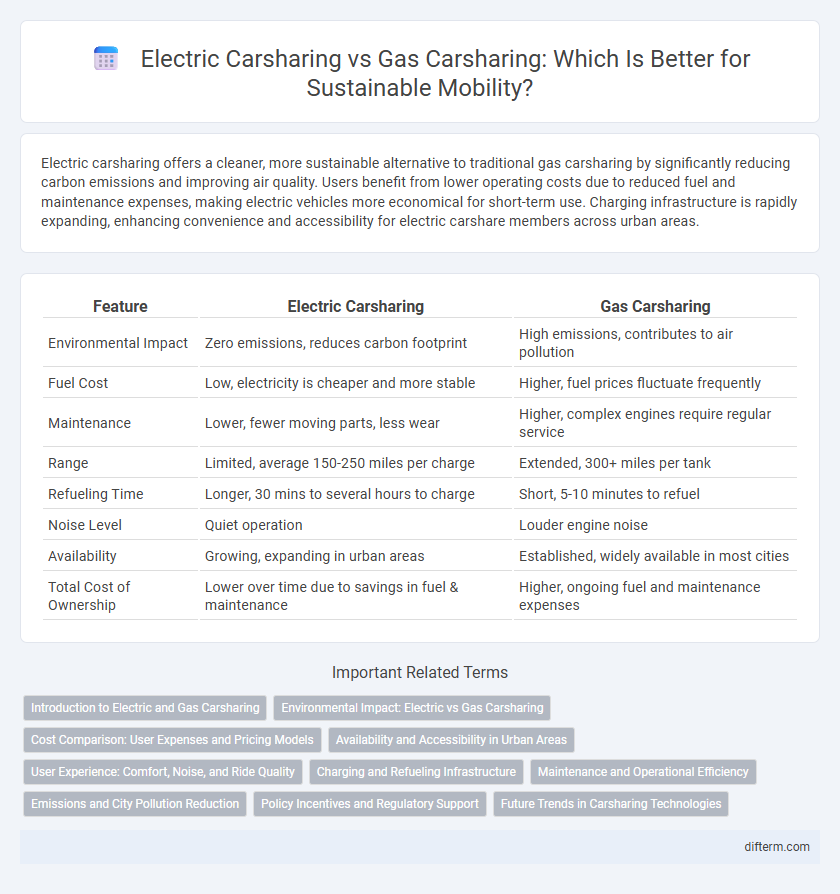Electric carsharing offers a cleaner, more sustainable alternative to traditional gas carsharing by significantly reducing carbon emissions and improving air quality. Users benefit from lower operating costs due to reduced fuel and maintenance expenses, making electric vehicles more economical for short-term use. Charging infrastructure is rapidly expanding, enhancing convenience and accessibility for electric carshare members across urban areas.
Table of Comparison
| Feature | Electric Carsharing | Gas Carsharing |
|---|---|---|
| Environmental Impact | Zero emissions, reduces carbon footprint | High emissions, contributes to air pollution |
| Fuel Cost | Low, electricity is cheaper and more stable | Higher, fuel prices fluctuate frequently |
| Maintenance | Lower, fewer moving parts, less wear | Higher, complex engines require regular service |
| Range | Limited, average 150-250 miles per charge | Extended, 300+ miles per tank |
| Refueling Time | Longer, 30 mins to several hours to charge | Short, 5-10 minutes to refuel |
| Noise Level | Quiet operation | Louder engine noise |
| Availability | Growing, expanding in urban areas | Established, widely available in most cities |
| Total Cost of Ownership | Lower over time due to savings in fuel & maintenance | Higher, ongoing fuel and maintenance expenses |
Introduction to Electric and Gas Carsharing
Electric carsharing offers a sustainable alternative to traditional gas carsharing by providing zero-emission vehicles that reduce urban air pollution and dependence on fossil fuels. While gas carsharing remains prevalent due to established fueling infrastructure and generally lower upfront costs, electric carsharing benefits from lower operating expenses and increasing availability of fast-charging stations. Integration of electric vehicles in carsharing fleets supports smart city initiatives and aligns with global carbon reduction targets, positioning electric carsharing as a key component in the future of urban mobility.
Environmental Impact: Electric vs Gas Carsharing
Electric carsharing significantly reduces greenhouse gas emissions by utilizing renewable energy sources, unlike gas carsharing which relies on fossil fuels that contribute to air pollution and climate change. Life cycle analyses show electric vehicles (EVs) in carsharing fleets produce up to 60% fewer carbon emissions compared to internal combustion engine vehicles over their operational lifespan. Reduced local air pollutants from electric carsharing also improve urban air quality, leading to better public health outcomes in densely populated areas.
Cost Comparison: User Expenses and Pricing Models
Electric carsharing typically offers lower user expenses due to reduced fuel and maintenance costs compared to gas carsharing, with average savings of 20-30% per trip. Pricing models for electric carsharing often include time-based rates combined with mileage charges, incentivizing shorter trips and higher turnover. Gas carsharing usually features higher fuel surcharges and fluctuating costs tied to gasoline prices, resulting in less predictable user expenses.
Availability and Accessibility in Urban Areas
Electric carsharing services offer greater availability in urban areas by providing numerous strategically placed charging stations and a higher density of vehicles compared to traditional gas carsharing. Accessibility is enhanced through seamless app-based booking systems and flexible pick-up/drop-off locations, making electric options more convenient for short, frequent trips in cities. These factors contribute to wider adoption of electric carsharing, promoting sustainable urban mobility with reduced emissions.
User Experience: Comfort, Noise, and Ride Quality
Electric carsharing provides a superior user experience by offering quieter rides and smoother acceleration compared to gas carsharing, enhancing overall comfort during trips. The reduced noise level inside electric vehicles minimizes cabin disturbances, allowing passengers to enjoy conversations or entertainment with ease. Improved ride quality in electric cars results from advanced suspension systems and instant torque delivery, creating a more enjoyable and relaxing journey for users.
Charging and Refueling Infrastructure
Electric carsharing relies heavily on an extensive charging infrastructure with strategically placed fast chargers that reduce downtime and increase vehicle availability. Gas carsharing benefits from widespread fuel stations offering rapid refueling, but often lacks the environmental advantages of electric vehicles. Investments in expanding EV charging networks and integrating smart grid technologies are crucial for supporting sustainable, efficient electric carsharing systems.
Maintenance and Operational Efficiency
Electric carsharing fleets benefit from lower maintenance requirements due to fewer moving parts and no need for oil changes compared to gas carsharing vehicles. The reduced frequency of repairs and simplified servicing schedules enhance operational efficiency, cutting downtime and maintenance costs. Furthermore, electric vehicles offer better energy efficiency, leading to lower operational expenses and a more sustainable mobility solution.
Emissions and City Pollution Reduction
Electric carsharing significantly reduces greenhouse gas emissions compared to gas carsharing by utilizing zero-emission electric vehicles that produce no tailpipe pollutants. Cities adopting electric carsharing fleets experience decreased air pollution levels, leading to improved urban air quality and lower health risks related to smog and particulate matter. This shift supports local climate goals by cutting carbon footprints and mitigating the negative impacts of traditional gasoline-powered transportation.
Policy Incentives and Regulatory Support
Electric carsharing programs benefit significantly from policy incentives such as tax credits, reduced registration fees, and dedicated parking spaces, which encourage adoption and operational efficiency. Governments often impose stricter emissions regulations and fuel economy standards, incentivizing shared fleets to transition away from gasoline vehicles toward electric models. Regulatory support includes grants for infrastructure development like charging stations, enhancing the viability and convenience of electric carsharing compared to traditional gas-powered options.
Future Trends in Carsharing Technologies
Electric carsharing is rapidly advancing with innovations in battery technology and smart grid integration, enabling longer ranges and faster charging times. Gas carsharing faces increasing regulatory restrictions and higher operational costs due to emissions standards, making electric vehicles (EVs) more economically viable. Future trends emphasize autonomous electric fleets and AI-driven fleet management systems that optimize vehicle availability and energy consumption.
electric carsharing vs gas carsharing Infographic

 difterm.com
difterm.com